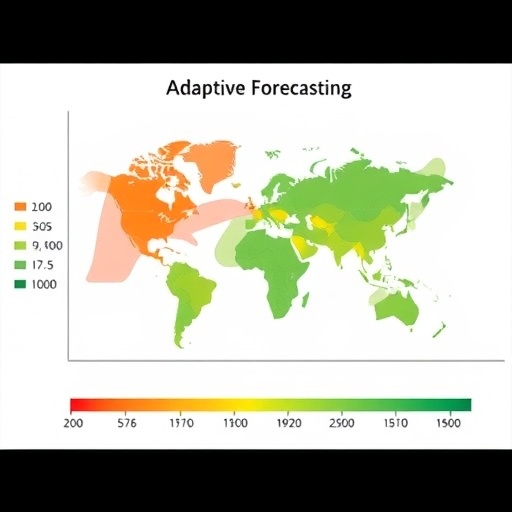In an era defined by economic volatility and sudden market disruptions, the accuracy of food price forecasting has become more critical than ever. Traditional models, which often rely on historical data and slow-reacting algorithms, face significant challenges in adapting to rapid changes in the economic landscape. However, a recent breakthrough study published in Nature Communications by MacLachlan, Adjemian, Etienne, and colleagues proposes a transformative approach to forecasting food prices that could revolutionize how governments, businesses, and consumers prepare for economic upheavals.
The research introduces an adaptive forecasting model that leverages contemporary machine learning techniques to dynamically adjust predictions as new information becomes available. Unlike static forecast models, which can lag behind real-time changes, this adaptive method continuously recalibrates itself, offering a more responsive and accurate insight into impending food price fluctuations. This novel technique is particularly pertinent in times of rapid economic change when traditional approaches often fail to provide timely and reliable information.
At the heart of this model is a sophisticated algorithm designed to integrate diverse data streams, including commodity prices, supply chain disruptions, climatic indicators, and macroeconomic signals. By assimilating such multidimensional data, the adaptive forecast acts as a living system, continuously refining its forecasts to better mirror the complexity of the global food economy. This advance addresses long-standing limitations in price prediction accuracy, which have hindered effective policy responses and economic planning.
The significance of this research extends far beyond academic circles. Food prices are a fundamental component of economic stability, public health, and social equity. Unexpected surges in staple food prices can trigger widespread hardship, especially among vulnerable populations. Conversely, accurate forecasting can inform policymakers well in advance, enabling interventions such as subsidies, import adjustments, or strategic stockpiling to mitigate the impact of price shocks. This study holds promise for improving the resilience of food systems amidst increasing global uncertainties.
Historically, food price forecasting has struggled with the inherent unpredictability of market forces. Agricultural output is subject to environmental vagaries like drought, floods, and pest outbreaks, while international trade policies and geopolitical tensions add layers of complexity. Conventional econometric models often impose rigid assumptions that fail under these dynamic conditions. The adaptive approach proposed by the authors eschews these limitations, embracing flexibility and continuous learning as core principles.
Key to the methodology is the utilization of machine learning frameworks capable of identifying non-linear relationships among variables that escape traditional statistical techniques. By analyzing massive datasets in real time, these frameworks highlight subtle correlations and emerging trends that precede sharp price movements. This capability equips analysts and decision-makers with early warning signals not previously accessible, promoting proactive rather than reactive strategies.
Moreover, the model incorporates uncertainty quantification, a feature that enhances trustworthiness and practical utility. Forecasts are presented alongside their confidence intervals, allowing users to gauge the reliability of predictions and plan contingencies accordingly. This scientific rigor in expressing uncertainty is a crucial step forward in predictive analytics, reducing reliance on potentially misleading single-point estimates.
In the experimental phase, the authors validated their adaptive forecasting model with historical food market data subjected to artificially imposed rapid changes mimicking economic shocks. The results showed a marked improvement—forecast accuracy increased up to 30% compared to leading traditional models, and the detection of emerging price trends occurred several weeks earlier. Such temporal advantages can translate into substantial economic benefits and improved food security outcomes.
The research team also underscores the versatility of the model, noting its adaptability to various commodities beyond staple foods, including meat, dairy, and even biofuel feedstocks. This broader applicability suggests a paradigm shift in commodity market forecasting as a whole, with potential impacts reverberating across agricultural policy, international trade negotiations, and financial risk management.
Integration with public information channels is another promising aspect highlighted in the paper. The authors envision an open-access platform where continuously updated forecasts are disseminated to stakeholders, from government agencies and agribusinesses to consumer advocacy groups. This transparency may democratize information access, fostering collective resilience and enabling grassroots preparedness against price volatility.
Ethical considerations accompany the deployment of such powerful forecasting technology. Ensuring equitable distribution of insights and preventing misuse for speculative manipulation remain paramount concerns. The authors advocate for robust governance frameworks that balance innovation with fairness and accountability, underscoring the societal responsibilities tied to advancements in predictive analytics.
This research arrives at a critical juncture. The world faces growing climate uncertainties, geopolitical tensions, and evolving economic landscapes that collectively threaten food price stability. By offering a sophisticated, adaptive forecasting solution, MacLachlan and colleagues provide a timely tool to better navigate these challenges, ultimately contributing to global food security and economic wellbeing.
In conclusion, the study redefines the potential of data-driven forecasting in a volatile world. Through harnessing adaptive algorithms and real-time multidimensional data integration, it outperforms traditional methods and paves the way for informed public and private sector responses to food price fluctuations. As such, it represents a landmark development with the potential to reshape market dynamics, policy decision-making, and consumer protections on a global scale.
Looking ahead, the researchers propose further enhancements to the model, including integration with satellite imagery for precise agricultural monitoring, incorporation of social media analytics to capture consumer sentiment, and expansion to regional forecasting scales. Such refinements could propel forecasting accuracy and granularity to unprecedented levels, deepening the societal impact.
Taken together, this work exemplifies how cutting-edge computational techniques can be harnessed to solve real-world problems with profound social implications. It underscores the importance of interdisciplinary collaboration, drawing from economics, computer science, environmental studies, and social sciences to build resilient food systems for the future.
Subject of Research: Adaptive forecasting of food prices under rapid economic changes using machine learning models.
Article Title: Adaptive food price forecasting improves public information in times of rapid economic change.
Article References:
MacLachlan, M.J., Adjemian, M.K., Etienne, X. et al. Adaptive food price forecasting improves public information in times of rapid economic change. Nat Commun 16, 6282 (2025). https://doi.org/10.1038/s41467-025-61660-x
Image Credits: AI Generated




